Frank Lloyd Wright’s 88th Birthday

This translation from Spanish (original text) to English is not professional. I have done it with Google, so there will be linguistic errors that I ask you to know how to hide. Many times I have been asked to read my texts in English, and that is why I decided to do it. In addition to your patience, if you see something that I can correct, and wish to notify me of it, I will be happy to do so. In the meantime, with its lights and shadows, here are the lines that I have written. Hugo Kliczkowski Juritz
On the side of the photo you can read “Spring Green, Wis. June 8: Wright celebrates his 88th birthday Frank Lloyd Wright, the world-famous architect, posed with his wife Olgivanna (right) and daughter Iovanna, at his 88th birthday celebration. More than 125 guests toasted Wright as he discussed a commission from King Faisal of Iraq to design and plan a cultural center on an island in the Tigris River in Baghdad. He described the order as “a wonderful gift.” The photo was published in the Saturday Evening Post on page 38.

Photography for an article on page. 30 of “Look Magazine”. Published
on September 17, 1957. Photograph by Michael A. Vaccaro
When Wright turns 90 on June 8, 1957, his daughter Iovanna Lloyd Wright (1925 – 2015) dedicates a poem to him, which he gives to him at Christmas.
Partially published in the summer of 1959 after her death, in the newsletter of the Pacific Arts Association, in an article that includes these lines in a message to the editors «I thought you might like to have this poem that our daughter Iovanna wrote for her birthday.» number 90 of his father, but he gave it to him for Christmas. “He enjoyed it and read it frequently to our friends.” Mrs. Frank Lloyd Wright.

To my father (published by Taliesin Fellowship, Taliesin West).
… “Dwellings that grew, In forests, sun and stone, In clods and clay strewn with stars. Time and its aeons, shape after wave, Wave after timeless wave lay reflected, In the pools, the mysterious glades, That spawned within his mind, And drew the spirit of the mountain, And the plain…»
There are 4 unnumbered pages, inside an envelope addressed to “Mrs. Mary Fritz, Spring Green, Wisconsin. The postmark says “Phoenix, May 16, 1959.” The return address: «Taliesin West, Phoenix Arizona“.

Wright’s life was intense, to say the least, as well as stormy and dramatic.
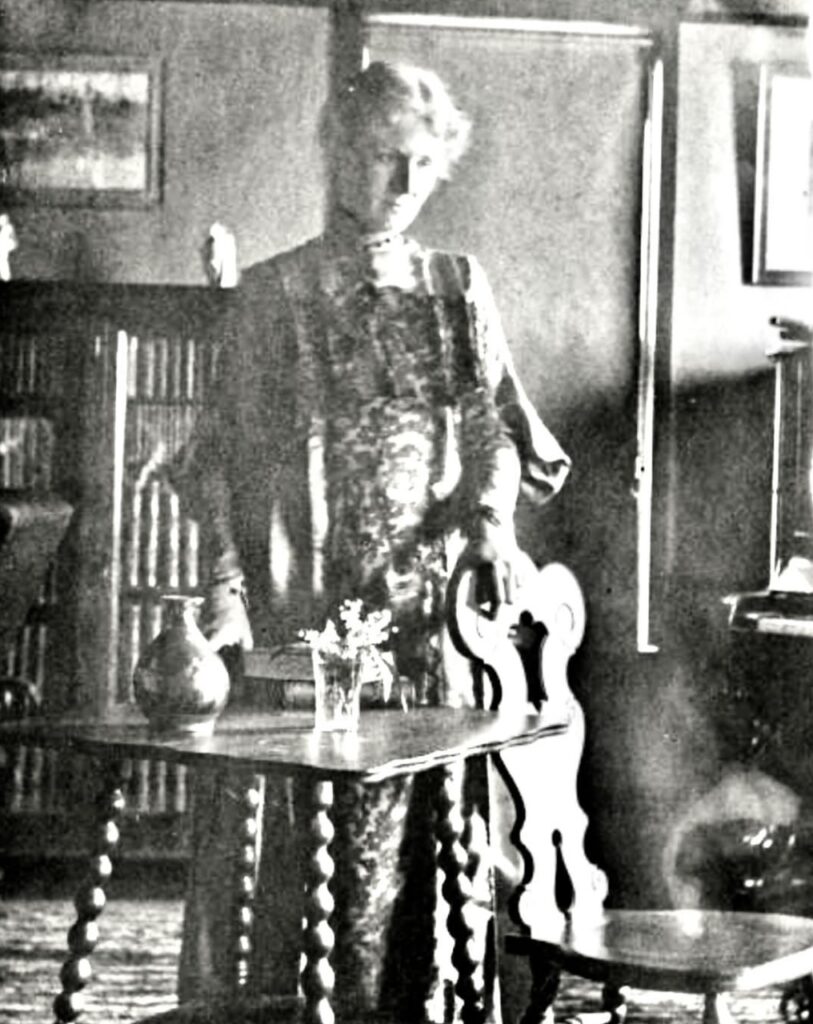
de la F.Ll.Wright preservation Trust
Not only does it include the abandonment of his first wife Kitty and his 6 children.
The act of “running away” with a client’s wife and its social and professional consequences. The disaster of the murder of Mamah Borthwick with her 2 children and 4 collaborators and the burning of her workshop house.
Marriage to a practically unknown person like Miriam Noel.
Until the peace that Olgivanna gave him, when she was 27 years old and he was 57.

Olgivanna’s creative spirit helped renaissance Wright’s career.
This occurred since they met in 1924 at a ballet show in Chicago, both were separating from their marriages.

Olgivanna had married at nineteen, had a daughter, and soon came under Gurdjeff’s influence (1). Shortly after meeting in 1925, they began planning a future together.
Frank’s separation from Miriam Noel (1869 – 1930) was traumatic.
In 1922, Kitty, Wright’s first wife, granted him a divorce, and a year later, in November 1923, he married Miriam in Spring Green. She met her almost immediately after Mamah Cheney’s tragic death on August 15, 1914, when Miriam sent her condolences to Wright.
Within weeks, Wright becomes deeply involved with Miriam, fulfilling her goal of moving to Taliesin.
In May 1924 Miriam left Taliesin, they had married 6 months earlier, and it was in November 1925 that Miriam filed for divorce, alleging abandonment and cruelty.
On April 20, 1925, a second fire broke out in Taliesin, destroying the homes.
On December 2, 1925, Olgivanna gives birth to Wright’s daughter, Iovanna Lazovich Lloyd Wright, in Chicago.
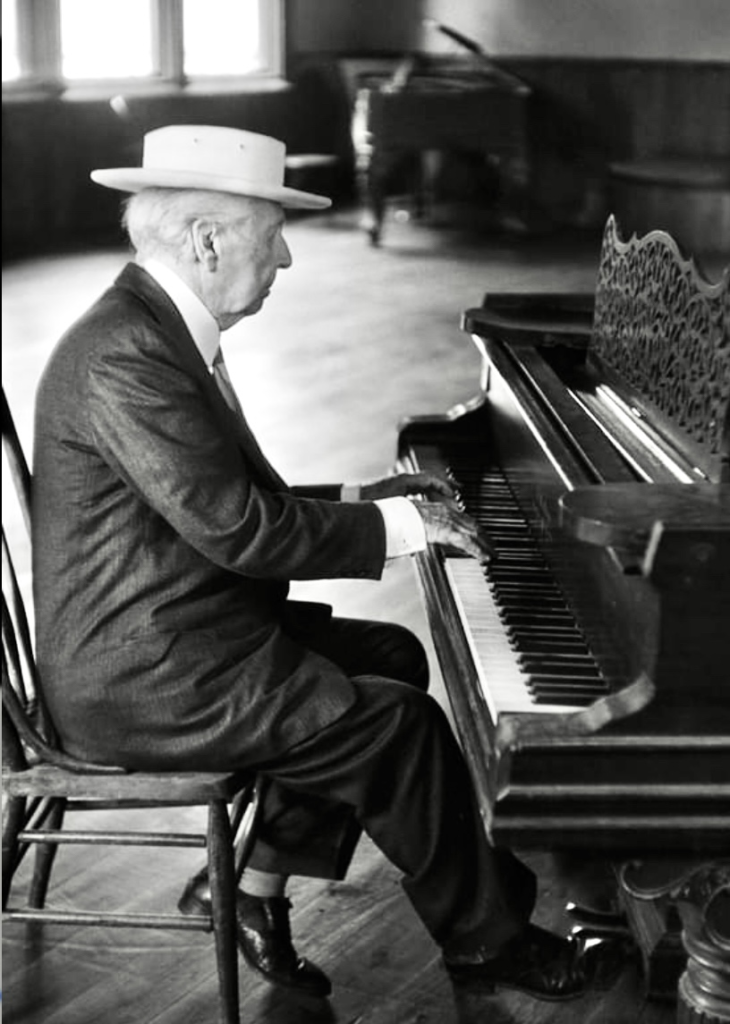
In May 1924 Miriam left Taliesin. They had married 6 months earlier, and in November 1925 Miriam filed for divorce, alleging abandonment and cruelty.
On April 20, 1925, a second fire broke out in Taliesin, destroying the homes.
On December 2, 1925, Olgivanna gives birth to Wright’s daughter, Iovanna Lazovich Lloyd Wright, in Chicago.
It seemed like the divorce might allow Wright to escape Miriam’s clutches, until she discovered not only that Olgivanna had entered Wright’s life, but that Olgivanna was pregnant.
During a period that lasted for years, Wright suffered (no doubt Noel too) years of harassment, accusations, counter-accusations and outbursts that were covered by the national press.
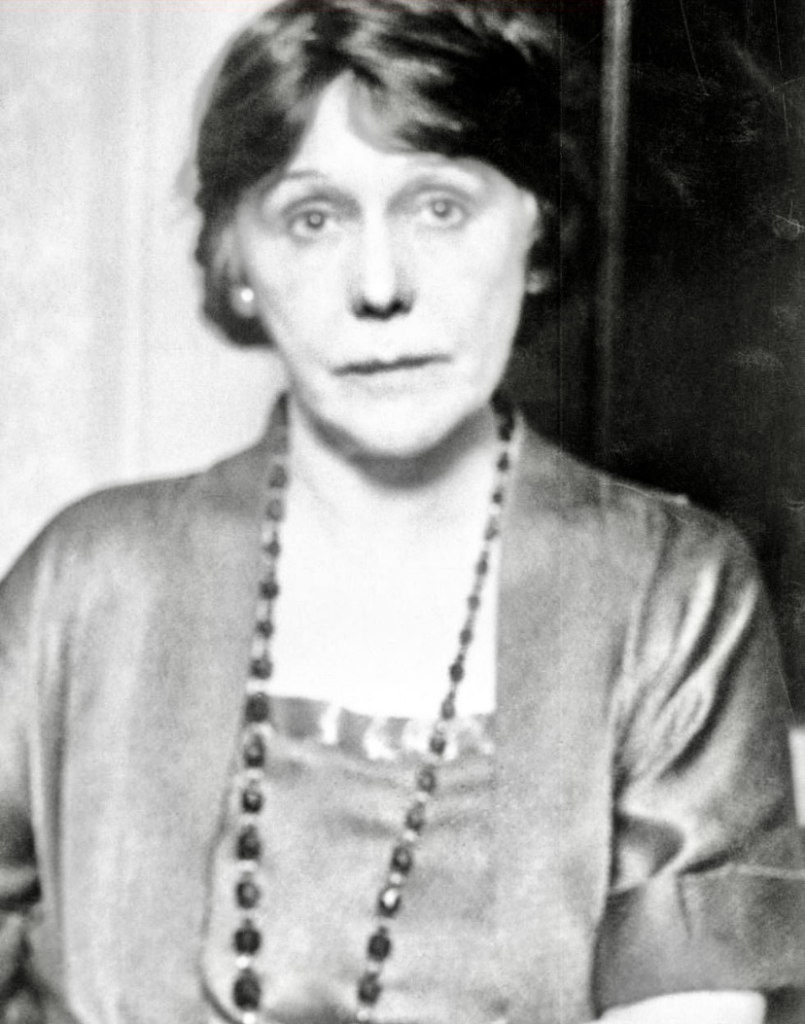
Wright became known more for his scandals than for his architecture, which posed a problem in attracting clients.
In Chicago, Miriam even attacked Olgivanna in the hospital in early December 1926. Enraged Miriam attempted (unsuccessfully) to storm Taliesin on June 3, 1926. In August of that year she demanded her right to live in Taliesin and sued Olgivanna, since “that pretty Russian dancer” claims, has usurped his rights.
A turbulent time, which included the October 21, 1926 arrest of Wright at the kitchen door of the cabin on Lake Minnetonka (26 km from Minneapolis in Missesota) that he had rented at the beginning of September.
After the arrest, Miriam awaits instructions from her lawyer at the Southmoor Hotel in Chicago, but she must disappear from there because she is evicted from the hotel and sued for non-payment of $1,500 (about $25.255 in 2022 dollars).
In 1927, Miriam was arrested in the dining room of the Lorain Hotel in Madison for sending an obscene letter to Wright.
From December 1926 to February 1927 Miriam lived in San Francisco, in the Claremont Apartments on Sutter Street.
He finally separated from Miriam on August 26, 1927, and Frank decided to travel with Olgivanna to Puerto Rico for two months.
In March 1928 Frank, Olgivanna and their children move to a cabin in La Jolla in California, in July of that year Miriam inevitably vandalizes the cabin and is arrested.
The year 1928 was chaos in Wright’s economy; in January the bank demanded payment of a mortgage and ordered him to abandon Taliesin, giving the order to put it up for sale. Shortly before, at the beginning of 1927, the bank had ordered Wright to sell some of his Japanese prints.
In October 1928 Wright, Olgivanna and the children returned to Taliesin.
Four years after meeting, and a year after separating from Miriam, on August 25, 1928, they married at midnight in Rancho Santa Fe near La Jolla. They spent their honeymoon in Phoenix, at the Arizona Biltmore Hotel.
On January 3, 1930, Miriam Noel died at the age of 61.
From the Plaza, he oversaw the Guggenheim Museum, and other projects in Westchester and Connecticut, as well as 3 smaller projects the Hoffmann Automobile Showroom (Manhattan), New Sports Pavilion (Long Island) and Cass House (Staten Island).

Oro Press has published a book about Oligivanna written by Maxine Fawcett-Yeske together with Bruce Brooks Pfeiffer (Director of the Frank Lloyd Wright Archives).
Pfeiffer had close contact with Olgivanna.
A+A magazine interviewed Fawcett-Yeske, this is the summary:
“…during one of my research trips to the Frank Lloyd Wright Archive in Taliesin West, Bruce Brooks Pfeiffer told me that Olgivanna had written an autobiography, raw, unpublished and read by very few people until that moment. As Bruce and I discussed the autobiography, it became clear to me that before preparing editions of selected works of Olgivanna’s compositions and before writing Mrs. Wright’s biography, her words should be allowed to speak for themselves. Thus began the work of compiling and editing what would become «Crna Gora to Taliesin, From the Black Mountain to the Shining Brow: The Life of Olgivanna Lloyd Wright…» Maxine Fawcett-Yeske.

Thanks to Olgivanna’s genius, the Frank Lloyd Wright School of Architecture, known as the “Taliesin Scholarship,” was formed.
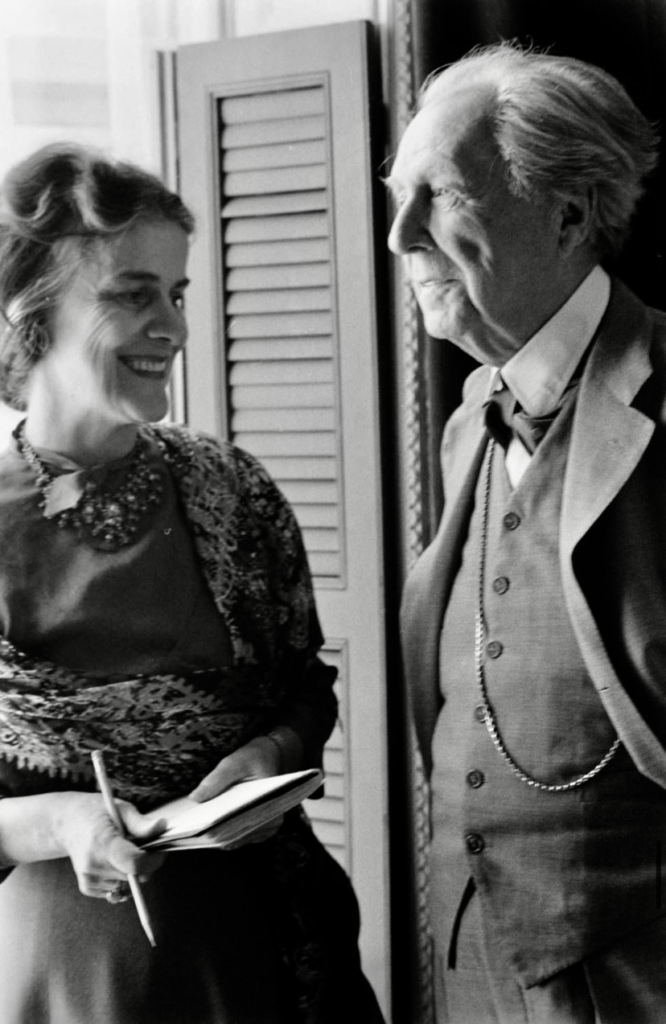
He oversaw all administrative aspects of the school, and the holistic curriculum, as he considered the “whole” to be a system more complex than the individuality of the parts.
In Taliesin, students/apprentices were taught that while developing architectural projects and delving into the secrets of art, they should know how to speak in public, while taking care of etiquette and decorum.
She was a writer, authoring five books on philosophy and the life she and Frank shared.
She was a composer, she composed more than forty musical compositions that enriched the lives of the apprentices, and that of the public who attended the music and dance festivals in Taliesin East (in Wisconsin) and in Taliesin West (in Scottsdale).
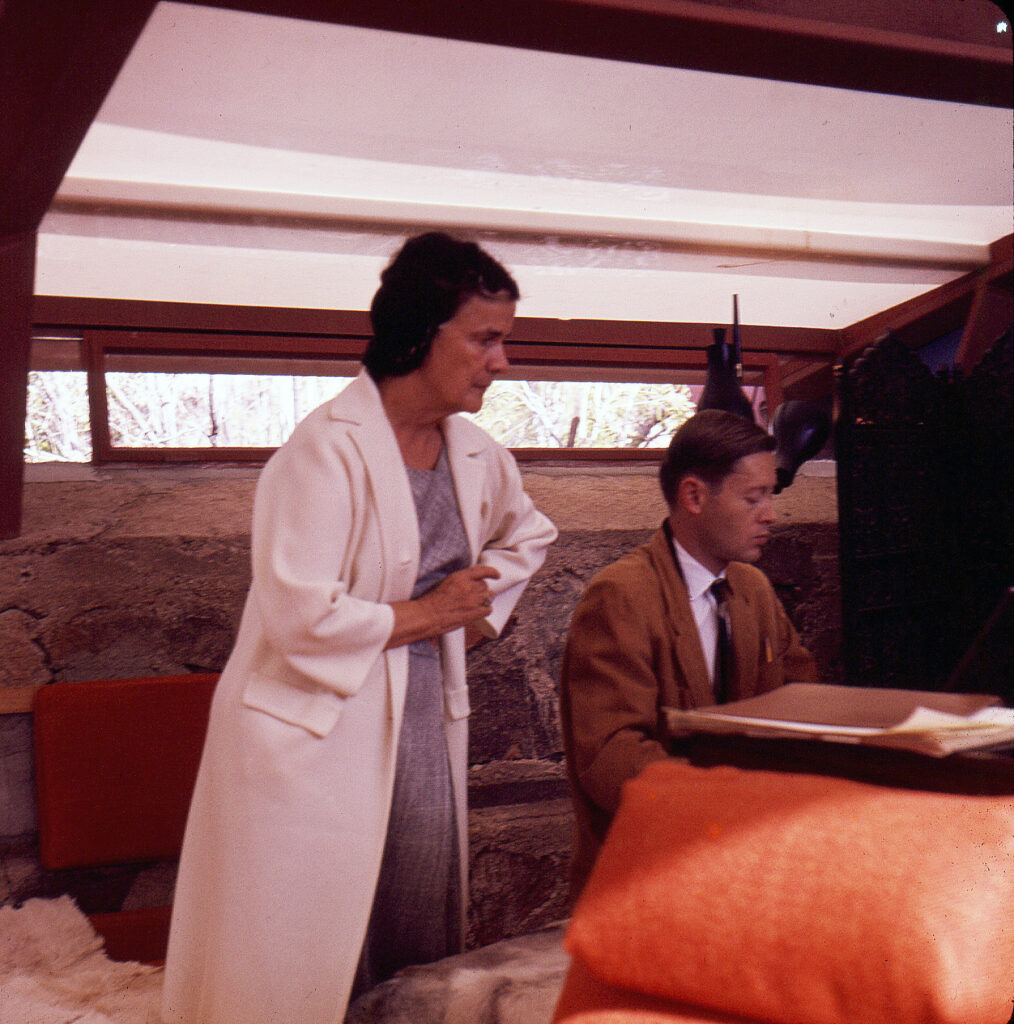
Perhaps she was an architect of the human spirit, she supported architectural apprentices, convinced that music, art, literature, dance and philosophy were «organic» and fundamental to the structural design of the mind, body and character, but basically it supported Frank’s genius, and allowed him to return to the path of architecture with capital letters.
Her full name was Olga Ivanovna «Olgivanna» Milijanov Lazovich Hinzenberg Lloyd Wright. He was born in Cetinje, then capital of the small principality of Montenegro.
His father, Iovan Lazovich, was the first president of the Supreme Court of Montenegro. His mother Melitza was a general in the Montenegrin army, daughter of Duke Marco Milijanov (1833-1901), a general credited with preserving Montenegro’s independence from Turkish rule in 1878.

Melitza was the youngest of three daughters of the duke, in the absence of children, Milijanov took her into the army to train her as a soldier. Olgivanna therefore came from a strong and diverse aristocratic background: a mother expert in social rebellion and military tactics and a father dedicated to peace and justice. Olgivanna’s father had gone blind at the time of her birth, so during her early childhood in Montenegro, she was her father’s eyes, reading him everything: newspapers, legal documents, books of poetry and philosophy, at the same time. who developed a vision of a world that was complex for his young age.
At the age of 9, he begins a more formal education in Russia. He lived with his sister Julia, who was married to the Russian nobleman Constantin Siberiakov, whose family owned gold mines in the Ural Mountains. At the age of 20 she married the Russian architect Vlademar Hinzenberg.
In Russia he studied for several years with the Greek-Armenian mystic and philosopher Georgi Gurdjieff (1866 – 1949). (1)
In 1917, at the time of the Bolshevik Revolution, Olgivanna fled Russia along with Gurdjieff and his followers, in that year her daughter Svetlana was born.

He lived for a time in Tiflis, Georgia, near the border with Turkey, together with Gurdjieff and his followers.

Horizon Press 1959. 308 pages, digitized by
The University of Michigan in 2007
From 1922 the Group taught at the Institute for the Harmonious Development of Man in Avon, in the Fontainebleau district.
Gurdjieff believed in the development of the “whole person,” mind, heart, and body. Her curriculum was strict, incorporating dance, exercise and physical work to overcome personal difficulties and find psychological discipline. The prestige of the Gurdieff Institute attracted many students such as the modernist writer Katherine Mansfield (pseudonym of Kathleen Beauchamp 1888 – 1923) who was in the care of Olgivanna due to her terminal state of tuberculosis. It is at the institute where Olgivanna trained as a dancer, musician, educator and philosopher.
They had no time for boredom, the experiences with learning and teaching, the Taliesin Scholarship, occupied them daily,

After Frank’s death on April 9, 1959, Olgivanna took it upon herself to explain Wright’s concept of “organic architecture” and talk about his life in ongoing talks. He continued to compose music until his death on March 1, 1985.

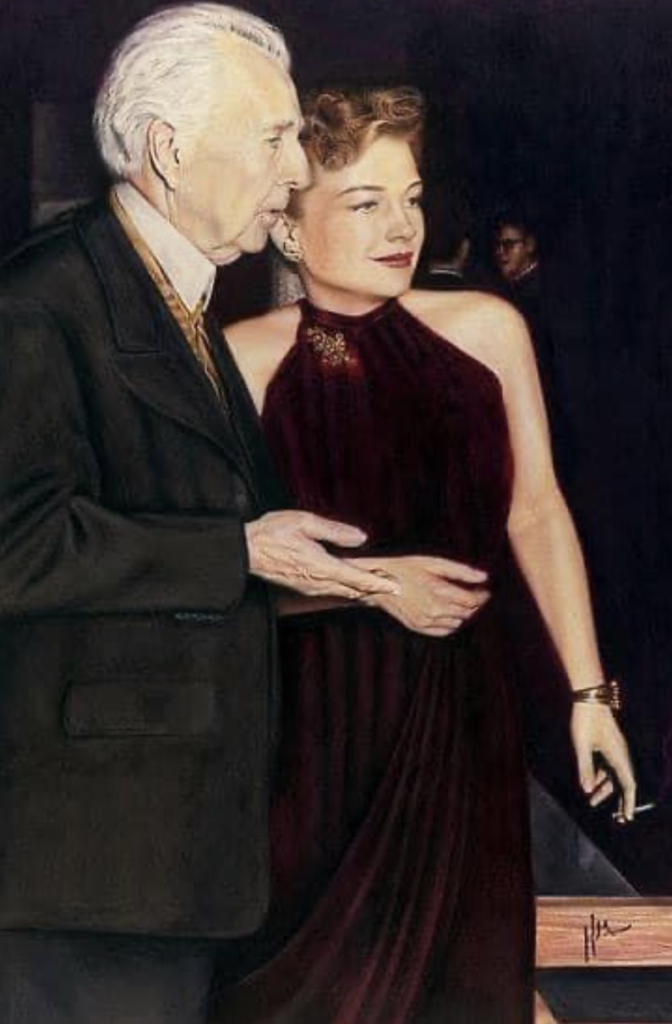
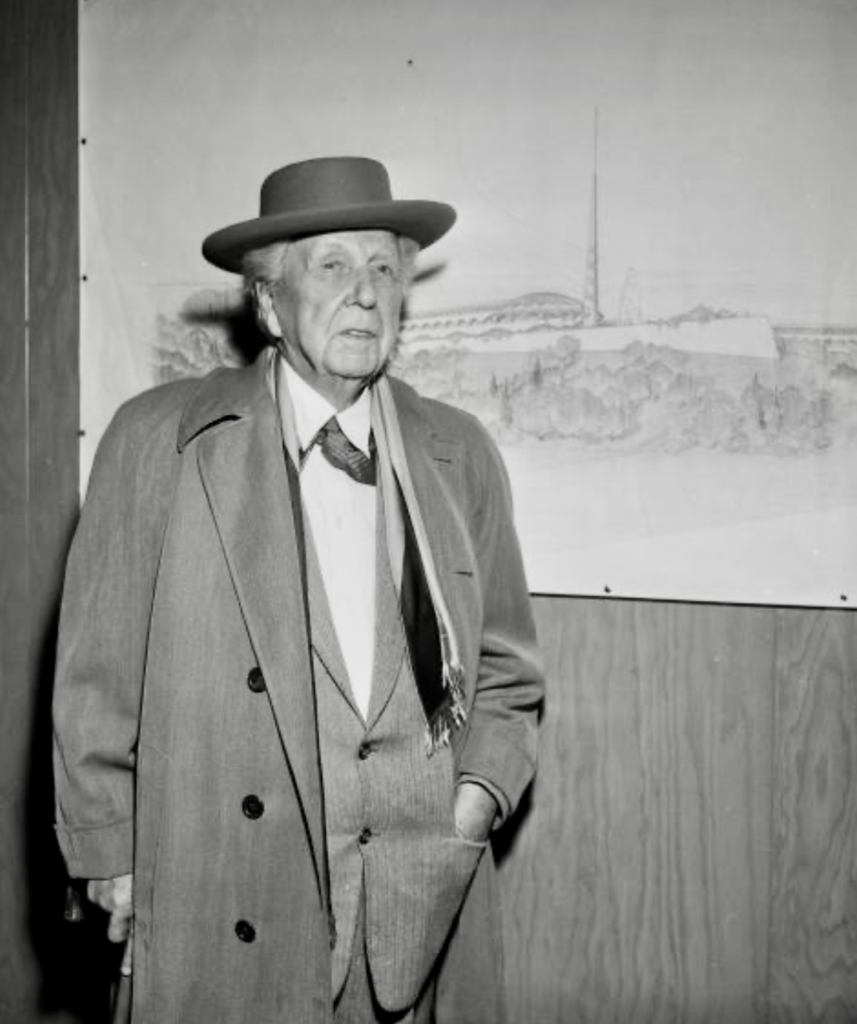
Friends who influenced Wright’s career
Wright’s most important promoter on the New York City cultural scene was Alexander Woollcott (1887 – 1943), theater critic, commentator, and writer for The New Yorker.

From 1929 to 1934 he wrote the column “Shouts and Rumors.”
His nickname was Aleck, he was a founding member and central figure in the Algonquin Roundtable. This “intellectual oasis on arid Broadway” began as a lunch meeting that accommodated authors, playwrights, illustrators, cartoonists, actors, artists, sculptors and celebrities.
“All the things I really like to do are immoral, illegal or fattening” Alexander Woollcott liked to confess.
Among his sharp-tongued peers, Woollcott became «the most courted and the most hated in the business.» A devastating theater critic, he was one of the most influential people on the American artistic scene of the first half of the 20th century.
Wright and Woollcott shared a warm and witty correspondence, charged with mutual admiration. Wright claimed that he had even attended some of the Algonquin Round Table meetings as a guest of Woollcott.
In 1919 the Algonquin Round Table included Art Samuels, Harpo Marx, Charlie MacArthur, Doroty Parker, and Alexander Woollcott. It served as an inspiration to the playwright George Simon Kaufman (1889 – 1961) and Moss Hart (1904 – 1961) to create the main character named Sheridan Whiteside in the play “The Man Who Saw Dinner.” Woollcott had a close friendship with Harpo Marx, (1888 – 1964), who actively collaborated in the revival of the career of the Marx Brothers. His book “While Rome Burns,” published by Grisset & Dunlap in 1934, was a best-seller.
His personality did not prevent him from broadcasting it permanently from his radio program on CBS “The Town Crier” (broadcast from 1933 to 1938), or from making comments like those he made about a pianist, composer, author, comedian and actor “There is absolutely nothing bad in Oscar Levant that a miracle cannot correct.”
The editor, theater critic and writer Wolcott Gibbs (1902 – 1958), who knew him very well, having worked for 31 years at The New Yorker magazine, wrote of him “You could extract each phrase without changing the general meaning… he was one “one of the most terrifying writers who have ever existed.”
Among Woollcott’s classic quotes is her description of the Los Angeles area as “Seven neighborhoods in search of a city” (some attribute it to her friend Dorothy Parker).

Notes
1
The Armenian-born mystic Ivanovich Gurdjieff taught dance techniques he called “Movements,” which he believed could transport his followers beyond the realm of the ordinary senses. In the early 1920s, Olgivanna was one of his leading devotees.
“Gurdjieff showed that the evolution of man… is the result of individual inner growth (and development)… such inner openness is the goal of all religions, of all paths… it requires direct and precise knowledge… which can only be acquired with the help of an experienced guide and through a prolonged study of oneself and work on oneself.” Perspectives from the real world. Introduction. Syrian Publishing House.
previous chapter http://onlybook.es/blog/las-obras-de-frank-lloyd-wright-parte-7-el-taa/
next chapter http://onlybook.es/blog/las-obras-de-frank-lloyd-wright-parte-9-casa-bach-y-the-illinois/
Our Blog has obtained more than One million readings: http://onlybook.es/blog/nuestro-blog-ha-superado-el-millon-de-lecturas/

Arq. Hugo Alberto Kliczkowski Juritz
Onlybook.es/blog
Hugoklico.blogspot.com

Salvemos al Parador Ariston de su ruina
Let’s save the Parador Ariston from its ruin
http://onlybook.es/blog/el-parador-ariston-una-ruina-moderna-por-hugo-a-kliczkowski/